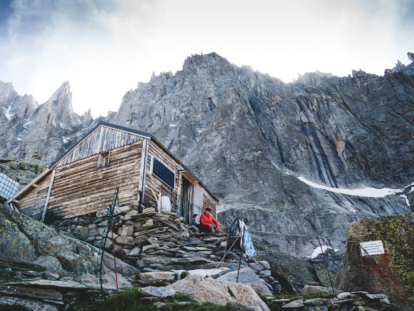The Charpoua Way
One family sets the pace at a historic refuge near Chamonix, France.
All photos by Pierre Cadot
The glacial bowl of Charpoua overlooks the right-hand side of the Mer de Glace (meaning “sea of ice”) near Chamonix, France. Surrounded by famous peaks such as Aiguille Verte (4,122 meters) and Les Drus (3,754 meters), Charpoua is a vantage point poised between heaven and hell, with the Flammes de Pierre ridge to the north and the ecclesiastical chain Moine-Nonne-Evêque-Cardinal to the southwest. A little one-room refuge holds court at the center of this granite sanctuary, nestled on top of an islet of rock.
Built in 1904 out of planks of pine carried up on the backs of the Chamonix Alpine Sports Club, the historic Refuge de la Charpoua is an essential stop for mountaineers climbing the legendary peaks of Les Drus. As both a start and end point for many great mountain routes and demanding modern climbs, the hut can only be reached after a long trek up from the Montenvers train station. Nerve-racking ladders, glacier crossings and unstable moraines are all part of the approach to the hut, which is far from a walk in the park. This is no tourist refuge. Only seasoned climbers and a few determined hikers will make it up to cross its threshold.
Eight years ago, Sarah Cartier, a young woman from Chamonix keen to be her own boss, decided to look after this outpost alone. From mid-June to late August, she offers board and lodging to climbers. She provides information, keeps an eye on their progress and administers first aid should it be necessary. She knows how to brush off chauvinist comments that are still too common in the traditionally male-dominated alpine world. And she does it all with her kids until the temperature drops and the glacier closes off access to Les Drus for the season.
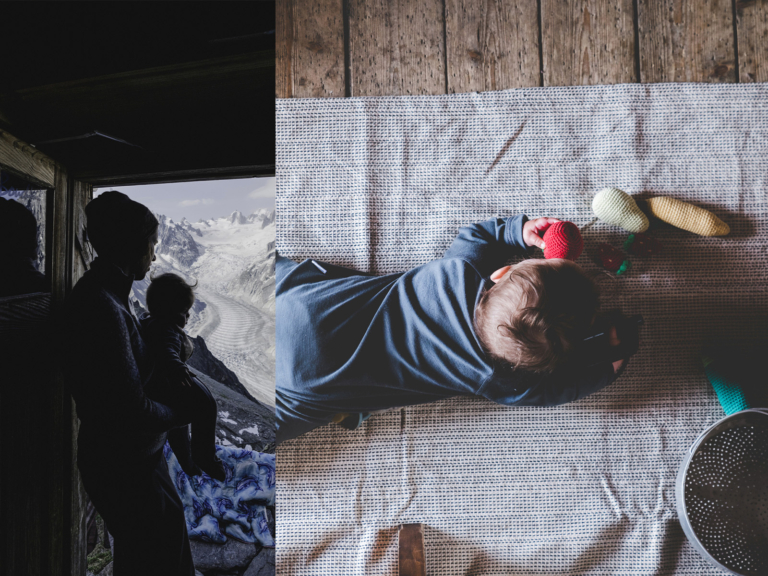
Left: Sarah Cartier and 10-month-old Camille look out over the Mer de Glace or “sea of ice.”
Right: Camille plays on the floor with a few typical baby toys, plus the better entertainment—a kitchen colander.
For Sarah, there was never any question of abandoning her role as the hut’s caretaker or leaving her family behind. With the support of her partner, Noé, she found a way to bring her family life into the high mountains. And so, in the 2019 season, her climb up to Charpoua was done with her first child, little Armand, on her back. During that first summer, he sat in a highchair in front of the window, where he could see outside and stare at the choucas (or alpine choughs, a very emblematic bird in the Alps). He became obsessed with them and at the end of the summer was able to mimic their calls, all before he learned to talk.
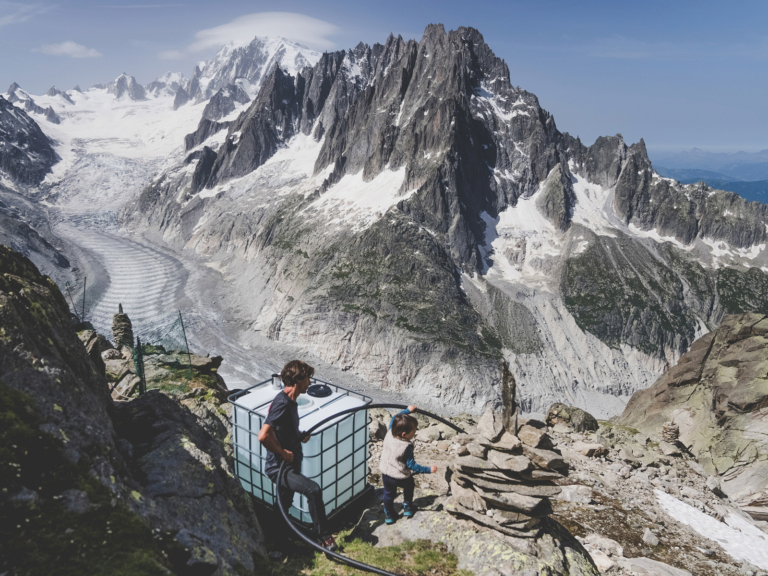
Théo, a hut helper, and 3-year-old Armand near the hut’s water reserves. Sarah has changed how travelers refill and access drinking water at Charpoua. She acquired a filter, which purifies the water in the hut’s catchment area. The result is a cheaper carafe for visitors, as well as saving transportation energy and about 250 plastic bottles.
With neither water nor electricity, the hut’s amenities are limited. Toilets perched behind the hut are little more than a few blocks of granite, and showers here are a distant fantasy. The building itself is made up of a single room. On one side is the kitchen, with its 100-year-old wooden table, and on the other are two wooden partitions separating nearly a dozen bunk beds. Everything is cleverly arranged so as not to waste an inch of space and to keep the mountaineers as comfortable as possible. The small size of the hut guarantees either human warmth or a cramped lack of privacy, all depending on the savoir-faire of the guests.
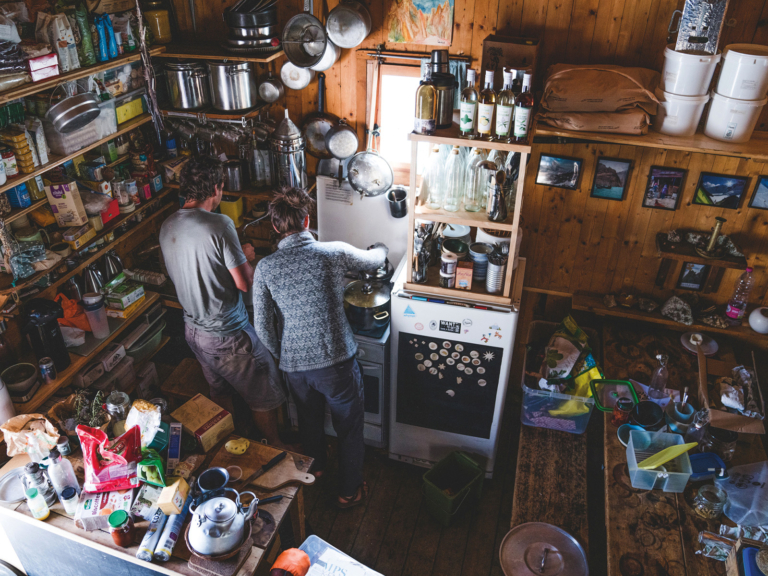
Sarah and her husband Noé cook shoulder-to-shoulder in a kitchen where everything must have its place. Guests sit in the corner to the right for all their meals. Now imagine two hungry kids in the picture, too.
With the addition of children, refuge life has adapted, and the space itself has undergone a few modifications. Netting has been set up around the terrace to prevent accidents, and a mini-bedroom annex, built by Sarah’s husband Noé, was lowered into position by helicopter, a few meters from the refuge. During the summer of 2022, 3-year-old Armand returned, and 10-month-old Camille came for the first time to Charpoua, too. More improvisation has been required, including a few volunteers that assist around the hut. But no one can resist Armand’s jokes in his skeleton pajamas, nor the huge smiles of Camille. Climbers often become impromptu babysitters when it’s time to make dinner.
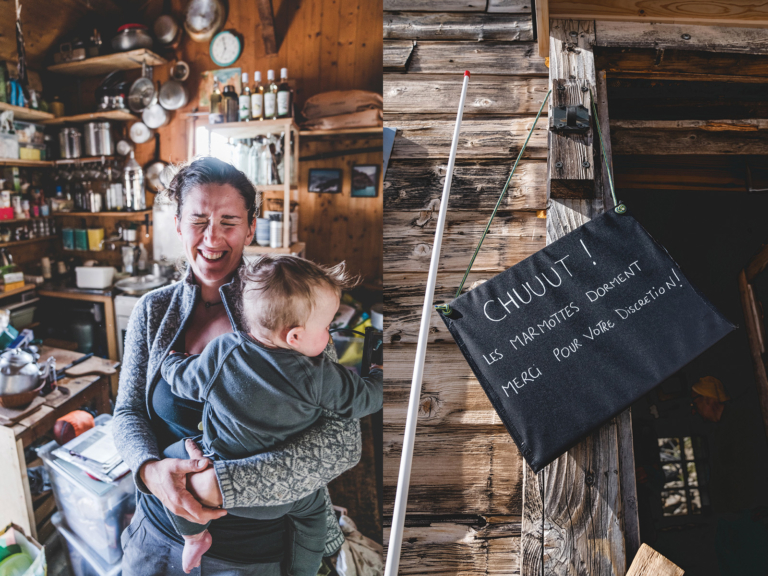
Left: Camille is usually found strapped to Sarah’s back so she can keep her hands free for all the doing that must be done.
Right: A sign asks visitors to please be quiet and respect the hut’s little sleeping mountain marmots, aka Armand and Camille.
Sarah and the kiddos wake up at 6:45 every morning to prepare for 7 o’clock breakfast and tidy any messes left from the 2 a.m. alpine-start meals. Then they share coffee with laid-back hikers or other people who slept in the refuge, already on their way back from big mountain objectives. Afterward, it’s all the typical work of a host—washing up, making the beds, tracking invoices and then starting to cook for dinner. Sarah tries to do most of her tasks in the morning so the kids can stay inside the cabin either because of weather or safety while momma is preoccupied. And like many people who work with their kids on their back, Sarah is usually found with Camille strapped tightly to her.
When the weather is nice, Sarah puts the baby playpen outside. When it isn’t, she makes a basic dough and helps Armand sculpt depictions of the storm noises they hear outside. What does wind and hail look like in monster-dough form? You have to visit Charpoua to find out.
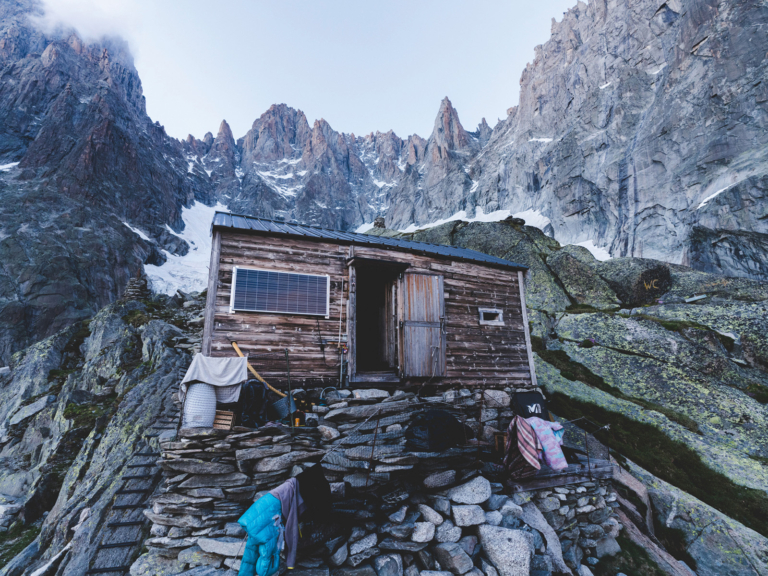
Le Refuge de la Charpoua on the Mont Blanc Massif, which has scarcely been modified since it was built in 1904 by the Chamonix Alpine Sports Club. Sarah, the refuge’s primary caretaker, has added a few modern additions, like net barriers to help prevent accidents for her children. The summer of 2023 will be the first year for major renovations, and it’s yet to be decided what those will be.
The family shares lunch together and hangs out in the afternoon, then it’s nap and bath time. Later, they welcome new guests for the night and get dinner ready before a last bit of washing up and bed. Sarah likes to think that she provides some pretty essential life tasks: hosting, serving food, looking after people and having to call for help if needed. They’re all wonderful things to teach the young. “Having children here has brought with it a certain rebalancing of relationships,” says Sarah. “When some of the climbers realize I’m bringing up my children alone here, they say that climbing Les Drus isn’t really such a big thing.”
